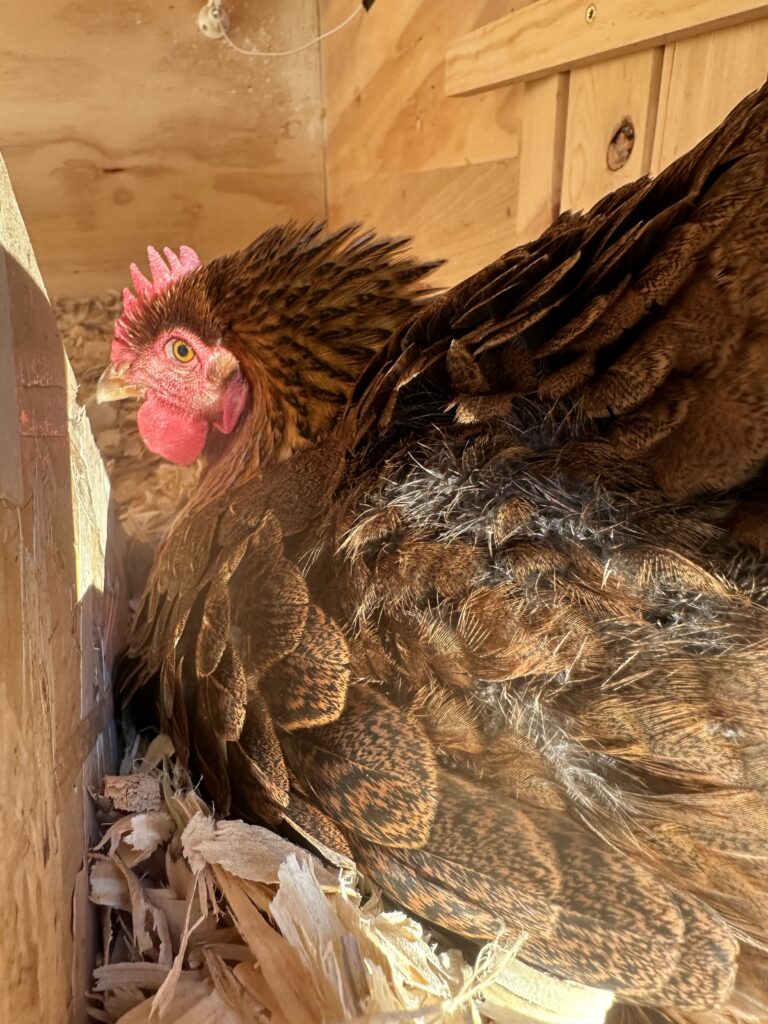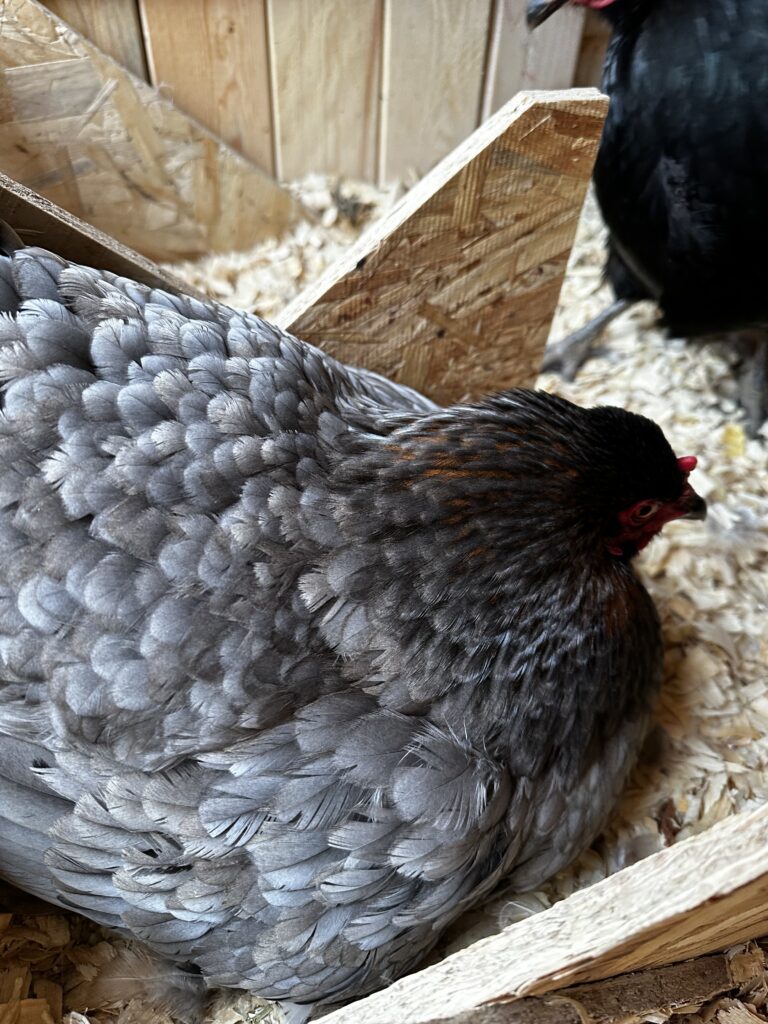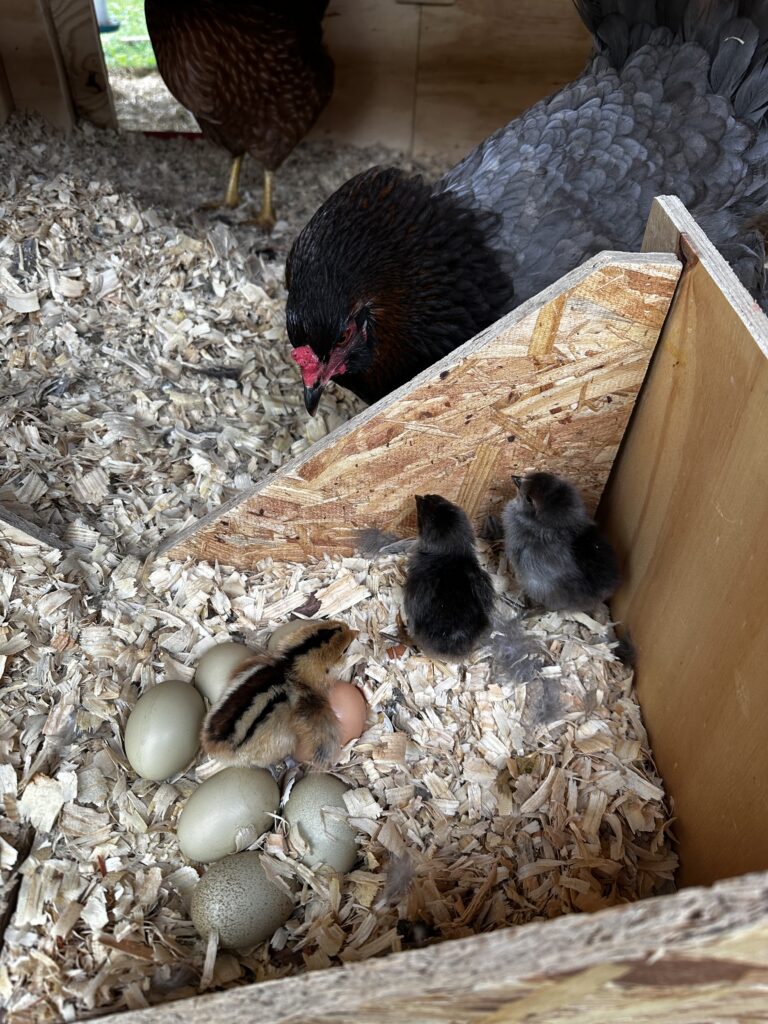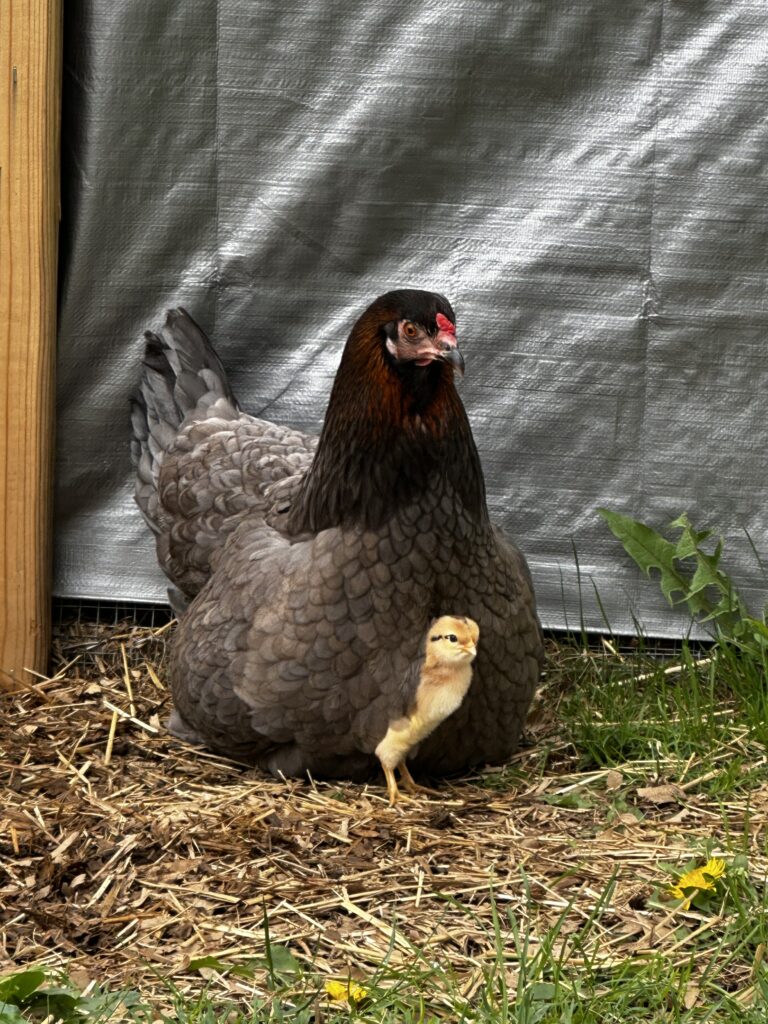Broody Hen Basics: What to Do When Your Chicken Goes Broody
If you keep chickens for long, you’ll eventually encounter a broody hen—the determined bird who decides she’s going to hatch eggs, whether you planned for it or not.
I’ve had four hens go broody so far, including one who sat through early winter and successfully hatched her chick just before Thanksgiving. It can feel a little intimidating the first time it happens, but with the right approach, it is one of the most rewarding aspects of raising chickens.
Here’s what I’ve learned about managing broody hens, deciding whether to let them hatch, and how to care for them while they sit.
What Is a Broody Hen?

A broody hen is a hen whose maternal instincts kick in. She stops laying eggs, fluffs herself up, and spends all day sitting on the nest—even if there are no fertilized eggs under her.
Some breeds are more prone to broodiness (like Cochins, Silkies, and Orpingtons), but in my flock, I’ve seen even less “broody-prone” birds decide it’s time.
How to Tell If Your Hen Is Broody
There are a few clear signs. She refuses to leave the nest box, even overnight, and will shriek like a banshee if you try to touch her. She puffs up her feathers to look larger and stops laying new eggs. A broody hen only gets off the nest briefly once or twice a day to eat, drink, She only gets off the nest briefly once or twice a day to eat, drink, and relieve herself (and trust me, you’ll know a broody poop when you see it—it’s about twice the size of a normal one), then returns to sitting as soon as possible.
Should You Break the Brood or Let Her Hatch?
This is a personal decision, and it depends on your situation. Some reasons you might choose to break the brood are if you don’t have a rooster or fertilized eggs, you don’t want more chicks, she’s losing too much weight or getting dehydrated, or the weather is extremely hot or cold.
On the other hand, you might decide to let her hatch if you have fertilized eggs or can source them locally, you’d like to grow your flock, and you want the experience of seeing a hen raise her own chicks. Personally, I’ve never had to break a brood. I prefer to let my chickens live as naturally as possible, and if they decide they’re ready to be mothers, who am I to tell them they’re wrong?
My Experience With Broody Hens in Different Seasons
One of my most memorable experiences was Poppy, a hen who went broody on Halloween. I debated whether to stop her since the nights were already dipping below freezing, but she was persistent. I set her up in a protected area of the coop, made sure she had plenty of bedding, and let her try.
Three weeks later, she hatched a single healthy chick. Even in cold weather, she kept the baby warm and safe. If you’re considering letting a hen hatch in late fall or winter, know that it can be done, but you need to be prepared to help if needed.

Setting Up a Broody Hen
If you let your hen sit, it helps to set her up in a separate space where she isn’t disturbed or bullied off the nest. I like to let them stay in their nest box, and only move it to the ground of the coop if I feel the babies will be too high when they hatch. Keep food and water within easy reach so she doesn’t have to go far, but avoid putting it close enough that they don’t need to move to access it. . Broody hens will only get up once or twice a day, so they need everything close by, but still need to be encouraged to get up and move for their own health.
If other hens have access, they’ll often lay new eggs in her nest. To avoid a staggered hatch, mark the eggs you want her to keep with a pencil and remove any extras each day. Make sure the nest has clean, dry bedding, although mama will do a wonderful job keeping things tidy. A clean setup is a healthy one, and while broody hens don’t usually soil their nests, they do leave large, stinky droppings nearby when they get up, so be prepared to tidy up!
Caring for a Broody Hen
While she’s sitting, check on her daily to make sure she’s eating and drinking. Keep an eye on her weight and general condition, since some hens lose body condition if they sit too long. Make sure she gets up once a day to stretch her legs and take care of herself. In cold weather, double-check that the nest stays dry and insulated.

Hatching and Raising Chicks
At around 21 days—sometimes a little earlier or later—you’ll start to hear faint peeping coming from under your hen. It’s always tempting to help when you see an egg starting to hatch, but unless there are obvious problems, it’s best to let the mother handle it herself. She knows exactly what to do.
At this point I will move a small chick waterer and feeder close by so the babies have food when they’re ready. Once 24-48 hours old, mama will start teaching them how to eat and drink – an experience you absolutely want to see at least once. If your feeder and water are already chick friendly and they can access them, no need for the baby feeders
Once the chicks have hatched, the broody hen will immediately begin caring for them. She keeps them warm by tucking them under her feathers and shows them how to eat and drink within the first day. Compared to raising chicks in a brooder, letting a hen do it naturally is much less work for you and often results in calmer, more confident birds.
For the first few weeks, she will be very protective. She’ll puff herself up and warn off any other chickens or curious flockmates who come too close. In my experience, the broody hen maintains this level of vigilance for at least a month or two. During that time, she is fully dedicated to the chicks, guiding them around the coop and run and making sure they find food and water. If another hen challenges them, she’ll step in to defend them without hesitation.
As the chicks grow and become more independent, you’ll notice the mother gradually stepping back. Eventually, she stops clucking to them and lets them start mingling with the rest of the flock on their own. This natural process of integration usually happens seamlessly. The other birds get used to the chicks over time, and the pecking order adjusts without much drama. By the time the mother decides she’s done—usually after about six to eight weeks—the young birds are already part of the group.
Watching a broody hen raise her own chicks is one of the most rewarding experiences you can have as a chicken keeper. It’s fascinating to see how instinctively she cares for them and how she manages to integrate them into the flock without any help.
Breaking a Broody Hen
If you need to stop broodiness, you can remove her from the nest box whenever you see her sitting, block off the nest, or place her in a wire-bottom cage (often called a broody breaker) for a few days. I’ve also found a frozen water bottle placed under her can cool her down enough to break a broody hen. The cool air under her helps reset her hormones and discourages sitting. Most hens will give up after about three to five days, though some determined birds take a bit longer.
Final Thoughts
Broody hens can be a challenge, especially the first time you deal with one. But they’re also a wonderful reminder of how natural and instinctive chickens are. Whether you decide to break the brood or let her hatch, the most important thing is to monitor her health and make sure she has everything she needs.

If you have questions about managing a broody hen—or want to share your own experiences—feel free to reach out or leave a comment. I’d love to hear your stories.
Discover more from Cluck N' Quack Chronicles
Subscribe to get the latest posts sent to your email.
